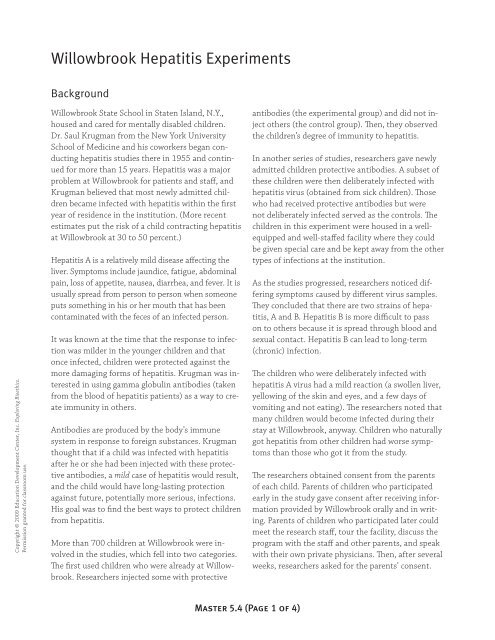Exploring Bioethics - NIH Office of Science Education - National ...
Exploring Bioethics - NIH Office of Science Education - National ...
Exploring Bioethics - NIH Office of Science Education - National ...
Create successful ePaper yourself
Turn your PDF publications into a flip-book with our unique Google optimized e-Paper software.
Willowbrook Hepatitis ExperimentsBackgroundCopyright © 2009 <strong>Education</strong> Development Center, Inc. <strong>Exploring</strong> <strong>Bioethics</strong>.Permission granted for classroom use.Willowbrook State School in Staten Island, N.Y.,housed and cared for mentally disabled children.Dr. Saul Krugman from the New York UniversitySchool <strong>of</strong> Medicine and his coworkers began conductinghepatitis studies there in 1955 and continuedfor more than 15 years. Hepatitis was a majorproblem at Willowbrook for patients and staff, andKrugman believed that most newly admitted childrenbecame infected with hepatitis within the firstyear <strong>of</strong> residence in the institution. (More recentestimates put the risk <strong>of</strong> a child contracting hepatitisat Willowbrook at 30 to 50 percent.)Hepatitis A is a relatively mild disease affecting theliver. Symptoms include jaundice, fatigue, abdominalpain, loss <strong>of</strong> appetite, nausea, diarrhea, and fever. It isusually spread from person to person when someoneputs something in his or her mouth that has beencontaminated with the feces <strong>of</strong> an infected person.It was known at the time that the response to infectionwas milder in the younger children and thatonce infected, children were protected against themore damaging forms <strong>of</strong> hepatitis. Krugman was interestedin using gamma globulin antibodies (takenfrom the blood <strong>of</strong> hepatitis patients) as a way to createimmunity in others.Antibodies are produced by the body’s immunesystem in response to foreign substances. Krugmanthought that if a child was infected with hepatitisafter he or she had been injected with these protectiveantibodies, a mild case <strong>of</strong> hepatitis would result,and the child would have long-lasting protectionagainst future, potentially more serious, infections.His goal was to find the best ways to protect childrenfrom hepatitis.More than 700 children at Willowbrook were involvedin the studies, which fell into two categories.The first used children who were already at Willowbrook.Researchers injected some with protectiveantibodies (the experimental group) and did not injectothers (the control group). Then, they observedthe children’s degree <strong>of</strong> immunity to hepatitis.In another series <strong>of</strong> studies, researchers gave newlyadmitted children protective antibodies. A subset <strong>of</strong>these children were then deliberately infected withhepatitis virus (obtained from sick children). Thosewho had received protective antibodies but werenot deliberately infected served as the controls. Thechildren in this experiment were housed in a wellequippedand well-staffed facility where they couldbe given special care and be kept away from the othertypes <strong>of</strong> infections at the institution.As the studies progressed, researchers noticed differingsymptoms caused by different virus samples.They concluded that there are two strains <strong>of</strong> hepatitis,A and B. Hepatitis B is more difficult to passon to others because it is spread through blood andsexual contact. Hepatitis B can lead to long-term(chronic) infection.The children who were deliberately infected withhepatitis A virus had a mild reaction (a swollen liver,yellowing <strong>of</strong> the skin and eyes, and a few days <strong>of</strong>vomiting and not eating). The researchers noted thatmany children would become infected during theirstay at Willowbrook, anyway. Children who naturallygot hepatitis from other children had worse symptomsthan those who got it from the study.The researchers obtained consent from the parents<strong>of</strong> each child. Parents <strong>of</strong> children who participatedearly in the study gave consent after receiving informationprovided by Willowbrook orally and in writing.Parents <strong>of</strong> children who participated later couldmeet the research staff, tour the facility, discuss theprogram with the staff and other parents, and speakwith their own private physicians. Then, after severalweeks, researchers asked for the parents’ consent.Master 5.4 (Page 1 <strong>of</strong> 4)
















